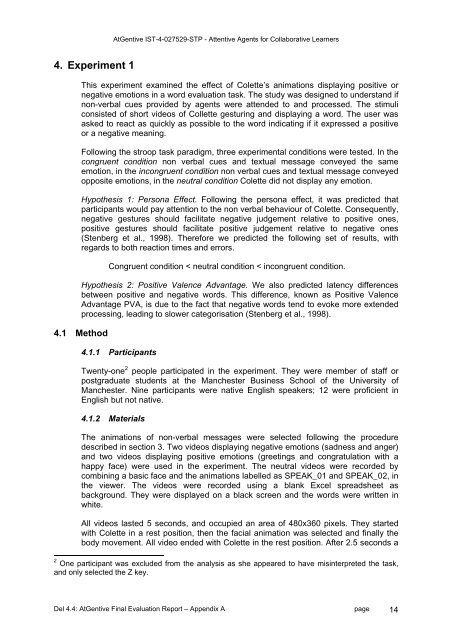Deliverable 4.4 - INSEAD CALT
Deliverable 4.4 - INSEAD CALT
Deliverable 4.4 - INSEAD CALT
You also want an ePaper? Increase the reach of your titles
YUMPU automatically turns print PDFs into web optimized ePapers that Google loves.
AtGentive IST-4-027529-STP - Attentive Agents for Collaborative Learners4. Experiment 1This experiment examined the effect of Colette’s animations displaying positive ornegative emotions in a word evaluation task. The study was designed to understand ifnon-verbal cues provided by agents were attended to and processed. The stimuliconsisted of short videos of Collette gesturing and displaying a word. The user wasasked to react as quickly as possible to the word indicating if it expressed a positiveor a negative meaning.Following the stroop task paradigm, three experimental conditions were tested. In thecongruent condition non verbal cues and textual message conveyed the sameemotion, in the incongruent condition non verbal cues and textual message conveyedopposite emotions, in the neutral condition Colette did not display any emotion.Hypothesis 1: Persona Effect. Following the persona effect, it was predicted thatparticipants would pay attention to the non verbal behaviour of Colette. Consequently,negative gestures should facilitate negative judgement relative to positive ones,positive gestures should facilitate positive judgement relative to negative ones(Stenberg et al., 1998). Therefore we predicted the following set of results, withregards to both reaction times and errors.Congruent condition < neutral condition < incongruent condition.Hypothesis 2: Positive Valence Advantage. We also predicted latency differencesbetween positive and negative words. This difference, known as Positive ValenceAdvantage PVA, is due to the fact that negative words tend to evoke more extendedprocessing, leading to slower categorisation (Stenberg et al., 1998).4.1 Method4.1.1 ParticipantsTwenty-one 2 people participated in the experiment. They were member of staff orpostgraduate students at the Manchester Business School of the University ofManchester. Nine participants were native English speakers; 12 were proficient inEnglish but not native.4.1.2 MaterialsThe animations of non-verbal messages were selected following the proceduredescribed in section 3. Two videos displaying negative emotions (sadness and anger)and two videos displaying positive emotions (greetings and congratulation with ahappy face) were used in the experiment. The neutral videos were recorded bycombining a basic face and the animations labelled as SPEAK_01 and SPEAK_02, inthe viewer. The videos were recorded using a blank Excel spreadsheet asbackground. They were displayed on a black screen and the words were written inwhite.All videos lasted 5 seconds, and occupied an area of 480x360 pixels. They startedwith Colette in a rest position, then the facial animation was selected and finally thebody movement. All video ended with Colette in the rest position. After 2.5 seconds a2 One participant was excluded from the analysis as she appeared to have misinterpreted the task,and only selected the Z key.Del <strong>4.4</strong>: AtGentive Final Evaluation Report – Appendix A page 14
















